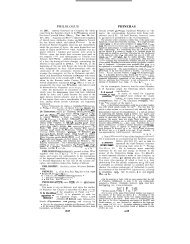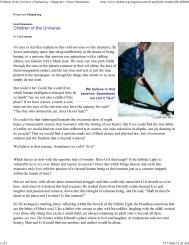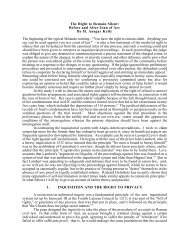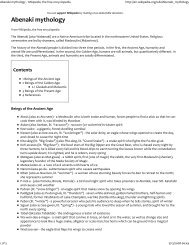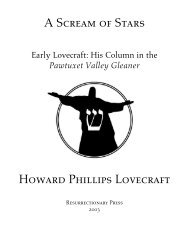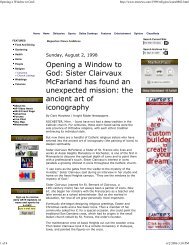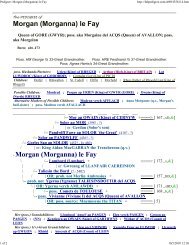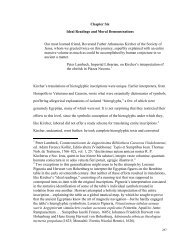sefi;g:v. - A Kabbalist walks into a bar, and the
sefi;g:v. - A Kabbalist walks into a bar, and the
sefi;g:v. - A Kabbalist walks into a bar, and the
You also want an ePaper? Increase the reach of your titles
YUMPU automatically turns print PDFs into web optimized ePapers that Google loves.
SEPHARVAIM<br />
‘ Zarephathites’ was a synonym for ‘ Jerahmeelites.’<br />
versiou).<br />
See OBADIAH, g- 5 end, n. I.<br />
1 Eg., by Wi. Alt. Unl. 101 : Bcnzinger, KHC, Kdn. 175.<br />
a See Wi. AOF2520.<br />
SERAH<br />
D:)I 150 (or ma), Sipar (or, Sippar) -maiml--i.e., ‘Sipar<br />
T. K. C.<br />
on <strong>the</strong> stream.’ Cp <strong>the</strong> phrase ‘ <strong>the</strong> stream of Sipar,’<br />
SEPHARVAIM (QD? ; variously C~IT@A~SIM, a title of <strong>the</strong> Euphrates (W 1 [1887], p. 267).<br />
-IN, -€IN, -OY&IM, -oyai~, OYMAIN [2 K. 1834, B], There is, however, a threefold difficulty in <strong>the</strong> above<br />
OT -OYN, CE@@A~OY&IM~ -0yt.i~~ -OYN, explanation of ‘ Sepharvaim ’ in z K. 1724. (I) The<br />
references. €ITl@&pOyAlMn, SIT@. I SI?@&p€Nl~ 3. Objectione Annals of ASur-bani-pal do not affirm<br />
€M@APIN C€IT@ApOy€M)9 whence <strong>the</strong><br />
that <strong>the</strong> king transplanted people from<br />
to current<br />
gentilic Sepharvitee (P’!lgPi?, 2 K. 1731a, Kt. in<br />
Babylon, Kutu (Cuth&), <strong>and</strong> Sipar.<br />
<strong>the</strong>ories.<br />
D. 31b P’mb). The references to a place, or places,<br />
but only that he comm<strong>and</strong>ed that <strong>the</strong>y<br />
called ‘Sepharvaim’ are in 2 K.1724 (cp 31), 1834 should remain alive, <strong>and</strong> caused <strong>the</strong>m to dwell in<br />
( =Is. 36 ~ g), 19 13 ( =Is. 3713). Taking <strong>the</strong> passages Babylon. ’ (2) The god specially worshipped at Sipar<br />
as <strong>the</strong>y st<strong>and</strong>, in contexts relating to <strong>the</strong> political was nei<strong>the</strong>r ‘ Adraninielech ‘ nor ‘ Anammelech ’ but<br />
intercourse between Assyria <strong>and</strong> israel or Judah, we Sam&. On <strong>the</strong> o<strong>the</strong>r h<strong>and</strong>, it is equally true that<br />
may venture to explain <strong>the</strong>m provisionally as follows, Sargon, who as a fact brought captive populations to<br />
reserving our own judgment to <strong>the</strong> end.<br />
Samaria (KB243 2. 20; cp SAMARIA), did not <strong>and</strong><br />
I. The passage z K. 18326-35 (Is. %18-20), which is could not includeany captives fromBabylon, Sepharvaim,<br />
plainly an interpolation (see Marti, <strong>and</strong> cp Znfr. Is. z18), etc., for <strong>the</strong> excellent reason that he made none <strong>the</strong>re.3<br />
seems to be based on z K. 1913 (Is. 3713), which may And (3) <strong>the</strong> <strong>the</strong>ory in question requires us to suppose<br />
refer to <strong>the</strong> Syrian city called in <strong>the</strong> Babylonian Chronicle that Avva <strong>and</strong> Hamath have been introduced <strong>into</strong> 2 K.<br />
ga<strong>bar</strong>ain, which was destroyed by Shalmaneser IV. 17 qfrom18 34 by RD,~ which is a complicated procedure.<br />
(see SIBRAIM).<br />
The question of Sepharvaim is <strong>the</strong>refore no simple<br />
2. The Sepharvaim of 2 K. 172431 (in which passages one. At present <strong>the</strong>re is’ no current <strong>the</strong>ory which<br />
captives of war appear to be referred to), however, is e Textual satisfies <strong>the</strong> conditions of <strong>the</strong> problem.<br />
more plausibly identified’ with Sipar, or Sippar, <strong>the</strong><br />
There is a strong a priori objection to<br />
criticism.<br />
city of SamaS <strong>the</strong> sun-god (Ztr+apa, Ptol. 5 18;<br />
distinguishing <strong>the</strong> Sepharvaim of z K.<br />
Zirrrapvv&v rbhis, Abyden. up. Eus. Prep. Ev.941), 1913 <strong>and</strong> 1834 (with <strong>the</strong> parallels in Is.) from that of<br />
famous from its association with <strong>the</strong> Deluge-story as 2 K. 1 j 24 31, <strong>and</strong> <strong>the</strong>re are three considerable difficulties<br />
given by Berossus, <strong>and</strong> regarded as one of <strong>the</strong> mabazi in this course, two suggested by Assyriology <strong>and</strong> one by<br />
rabdti, or ‘great capitals.’a This place was one of literary criticism. Let us, <strong>the</strong>n, approach <strong>the</strong> subject,<br />
<strong>the</strong> three cities which maintained <strong>the</strong> great Babylonian bearing in mind <strong>the</strong> gradually accumulating evidence<br />
revolt aRainst - Ah-bani-pal <strong>the</strong> loneest. It was on <strong>the</strong> for <strong>the</strong> apparently destructive but in reality conservative<br />
I<br />
a. Assyriologicd left or eastern bank of <strong>the</strong> Euphrates ; <strong>the</strong>ory that many passages both of <strong>the</strong> narrative <strong>and</strong> of<br />
<strong>the</strong> site was identified with <strong>the</strong> <strong>the</strong> prophetic books have been recast, <strong>and</strong> provided<br />
evidence’<br />
mounds of Abu Habba. about 16 m. with a new historical <strong>and</strong> geographical setting. It is<br />
SE. of BaghdZd, by <strong>the</strong> explore; H. kassam, who by no means an impossible view that <strong>the</strong> passages in<br />
found here a large stone with a representation of <strong>the</strong> Kings <strong>and</strong> Isaiah here referred to have been recast by<br />
shrine of SamaS <strong>and</strong> short inscriptions, dating from <strong>the</strong> an editor to suit his own <strong>the</strong>ory of <strong>the</strong> course of later<br />
time of king Nabu-abla-iddina (about 800 R.c.). The Israelitish history (see SENNACHERIB, § 5). This view<br />
builder of <strong>the</strong> temple was Naram-sin (about 3750 B.c.), implies that <strong>the</strong> names of <strong>the</strong> cities mentioned <strong>the</strong>re<br />
whose original inscription was found by Nabu-na’id have come out of somewhat similar names of places on<br />
(about 490 B.c.), one of <strong>the</strong> royal restorers of <strong>the</strong> <strong>the</strong> N. Arabian border of Palestine.<br />
Sepharvaim, like Rezeph in 2<br />
sanctuary. The temple was held in high honour ; one<br />
K. 19 12 (Is. 5712). will <strong>the</strong>n be<br />
a distortion of Sarephath, one of <strong>the</strong> most important places in<br />
of <strong>the</strong> most constant titles of SamaS was, ‘<strong>the</strong> great that region (see ZAREPHATH), or ra<strong>the</strong>r <strong>the</strong> final letters 0.1 (MT<br />
lord, dwelling in fi-<strong>bar</strong>a, which is within Sipar’ D;!, uapk) are, toge<strong>the</strong>r with (MT l$, ‘to, or of, <strong>the</strong><br />
(Pinches, TSBA 86 164fi). But <strong>the</strong>re was also a<br />
second divinity, called Anunit, who was specially<br />
worshipped at Sipar. In <strong>the</strong> Synchronous History<br />
(2 18-21), Durkurigalzu is said to have conquered Sipar<br />
city’), p>n (MT Y!?, ‘Hena’?), <strong>and</strong> possibly 7191 (MT, 7JW,<br />
‘<strong>and</strong> Ivvah’?), representatives of $xom* Uerahmeel). !t is<br />
noteworthy that <strong>the</strong> god worshipped by <strong>the</strong> ’Sepharv~tes<br />
receives <strong>the</strong> double name ail^ <strong>and</strong> ?$my (2 K. 1751). In<br />
of SamaS <strong>and</strong> Sipar of Anunitu (KBl~gg; Sayce, <strong>the</strong> latter form 3 has displaced 1 (cp yi>p <strong>and</strong> 13~); probably<br />
TSBA 2131) ; <strong>the</strong> Anunitu referred to was <strong>the</strong> consort <strong>the</strong> best intermediate reading is ~ $~i~,<br />
<strong>the</strong> original of which is<br />
of <strong>the</strong> sun-god. We must not, however, use this<br />
statement to confirm Schrader’s (very natural) explanation<br />
of ANAMMELECH (z K. 1731) as =Anu-malku,<br />
for if Anu (<strong>the</strong> heaven-god) were designated ‘king’<br />
in Assyria, <strong>the</strong> word used would not be malku (‘ prince ’)<br />
but farm.<br />
Dr. W. H. Ward (PYOC. Am. Or. Soc., 1885, pp. 29J)<br />
thought that he had found <strong>the</strong> site of a double city of<br />
Spar (Sepharvaim, dual?) at <strong>the</strong> mod. el-An<strong>bar</strong>, a few<br />
miles from Sufeira, WNW. of BaghdM, where, from<br />
<strong>the</strong> appearance of <strong>the</strong> ruins, it is evident that a canal<br />
was conducted from <strong>the</strong> Euphrates <strong>into</strong> <strong>the</strong> heart of <strong>the</strong><br />
surely $pmni* Uer?l)mFel).S The rite of sacrificing children<br />
was apparently drstlnctrve of some famous sanctuary in Jerahmeel<br />
(see MORIAH, <strong>and</strong> cp Cd. Bib. on Gen. 222 Jer. 2 34 11 15).<br />
The o<strong>the</strong>r passages which have to be considered in this<br />
connection are Ezra48-ro(see SHUSHANCHITES) <strong>and</strong> Is. 109 (see<br />
Crit. 172.). See also REZEPH.<br />
See especially Winckler, Alf. Unl. roo-103; <strong>and</strong> cp Cheyne,<br />
Ex#. T, 1898, P. 428f: T. K. C.<br />
BEPEELA (ce+~ha [AKC.aC.bl, c. ITEAINH kN*Vl,<br />
Vg. Sephela), I Macc. 12 38, RV ‘ plain country. See<br />
SHEPHELAH ; also JIJDEA, col. 2617.<br />
SEPTUAGINT. See TEXT A~ERSIONS, $5 46-55.<br />
SEPULCHRE (PP, Gen. 236 etc. ; MNHMBION,<br />
ciry. Dr. Ward found <strong>the</strong>re a small tablet on which<br />
three or four Sipars were mentioned, <strong>and</strong> he supposed<br />
’An<strong>bar</strong> to represent at once Spar Sa Anuniturn <strong>and</strong><br />
Agan6 (Peters, i\iipPur, 1 176 355 [Dr. Ward‘s diary]).<br />
If so, Sipar Sa Anunitum was a more considerable city<br />
than Sipar of SamaS (Abu Habba). But we can hardly<br />
admit that <strong>the</strong> duality of <strong>the</strong> city which lies under <strong>the</strong><br />
mound of el-An<strong>bar</strong> is made out. Most probably <strong>the</strong><br />
form Sepharvaim is erroneous. Ei<strong>the</strong>r <strong>the</strong> editor confounded<br />
‘ Sipar ’ with <strong>the</strong> ’ Sepharvaim ’ of 2 K. 19 ‘3,<br />
or, as Haupt proposes, we should restore <strong>the</strong> reading<br />
Mk. 1546 etc.). See TOMB, RESURRECTION.<br />
SERAH (nfp, in pause nfD, AV SARAH in NU.<br />
2646 ; cap& [L]), daughter of ASHER [q.~., § 41 ;<br />
Gen. 4617 (caap [A], cappa [Ol), Nu. 2646 (KAPA<br />
[B v. 30 capa ; BabAF])=l Ch. 730 (cope [B], CAPN<br />
CAI, -Ah PI).<br />
1 Cp @E 2 K. 18 34 crrmprrpovpcrv.<br />
2 KB 2 1;3 (foot) : .‘p Ki. Kdn. 276.<br />
3 See Wi. Alt. KJnz‘. 99.<br />
4 Ibid. xorf:<br />
5 The most plausible alternative original is Marduk ’<br />
or ‘ Merodach’ (cp NISROCH). This is favouredxy Nergal’ in<br />
4371<br />
-.<br />
<strong>the</strong> =me list. But it mmst perhaps be owned that ‘Nergqh‘ is<br />
only il little less doubtful than ADRAMMELECH ty.ri.1.<br />
4372



